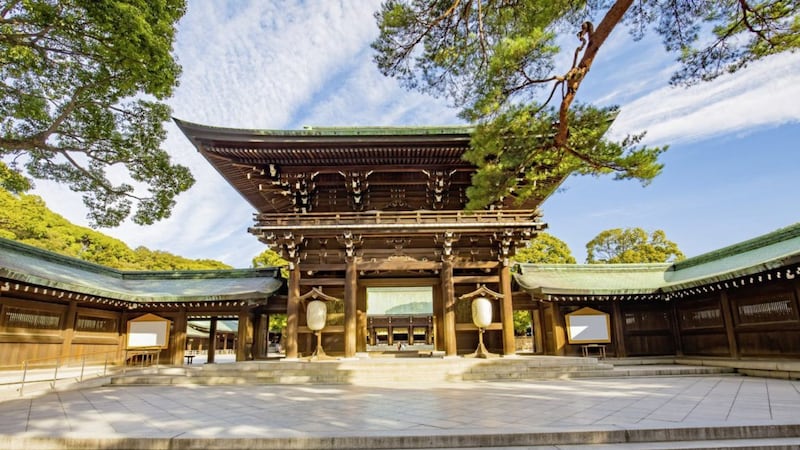ALL roads in Japan lead to Nihonbashi. In the early 17th century, when shogun Tokugawa Ieyasu's military government rose to power and enforced a strict hierarchical class system, Kyoto was the country's seat of power. This bustling district of Tokyo (then called Edo) became the starting point of five major routes linking the outer provinces.
A newly constructed wooden bridge over the Nihonbashi River drew entrepreneurial merchants, laying the foundations of a power shift from West to East, that confirmed Tokyo as the new capital in 1868.
Today, Nihonbashi is a thriving financial centre and shopping haven that cherishes past and present. A proud sense of community extends to local residents and businesses sharing civic cleaning duties. Speciality shops frequently collaborate, and the neighbourhood has a free shuttle bus, which is partly powered by used cooking oils from local restaurants.
The iconic wooden bridge has been rebuilt 19 times since 1603, and the current stone structure, flanked by statues of winged chimerical Kirin, houses the 'kilometre zero' stone of Japan. Seven national roads are measured from here.
The immaculately renovated Fukutoku Shrine with 9th century origins on the north side of the river, promises good luck with lotteries, which might pay for an exquisite Kyoto kimono priced JYP 3,400,000 (around £22,400) from the country's oldest department store, Mitsukoshi (mitsukoshi.mistore.jp).
Founded in 1673, the flagship building in Nihonbashi ushers shoppers through a Renaissance-style entrance flanked by two bronze lions, which were made in England to replicate Trafalgar Square's majestic guardians.
Walking around the district, I'm repeatedly drawn to artisan craftsmen of generations-old family businesses that continue to thrive beneath the gleaming skyscrapers of a hyper-modern capital. Confectionery house Eitaro Sohonpo first traded in 1857 and woos customers with signature kintsuba flour-coated rolls of sweet bean paste and moreish mochi sticky seaweed rice cakes.
Over the bridge, Yamamoto Noriten has been plying nori seaweed for more than 160 years. White-gloved staff prepare delicate green sheets surrounded by Hello Kitty-themed tins of seaweed, flecked with fragrant and tart yuzu.
Ninben dates back even further, to 1699, and pioneered the katsuobushi dried fish flakes, which are a vital ingredient of dashi stock that underpins Japanese cuisine. Meanwhile, fan makers Ibasen hark back to 1590, before the Edo period, and are renowned nationally for their painstakingly handcrafted artistry.
The district's sense of pride in its heritage is humbling, but Nihonbashi is also enthusiastically looking to the future. Banners for the Tokyo 2020 Summer Olympics flutter proudly along thoroughfares, and the skeletal structure of an oval wooden-latticed national stadium, inspired by the architecture of Japanese temples, is visible to the west in Shinjuku.
This warm, welcoming city is under starter's orders, and I'm ready and set to explore further...
WHERE TO STAY
Handcrafted elegance walks hand-in-hand with hi-tech ingenuity in the 157 rooms and 22 suites of the luxurious, five-star Mandarin Oriental, Tokyo.
Nestled predominantly on the nine uppermost floors of the Nihonbashi Mitsui Tower, this high-rise haven of serenity boasts 12 eateries and bars – three with glittering Michelin stars – including a hidden private dining room encircled by more than 5,000 bottles of wine. An airy gym with panoramic views inspires virtue after the gluttony, then relax in the award-winning spa on the 37th floor, which skilfully fuses Asian and Western-inspired traditions.
My west-facing Grand Room on the 36th floor, decorated in earthy tones, seduces me with a breathtaking view of snow-capped Mount Fuji, walk-in rainforest shower and yukata kimono-style night robe. Rooms start from JYP 57,000 (£375) per night.
WHERE TO EAT
Tokyo is a gastronomic paradise crammed with over 180,000 restaurants, including more than 200 establishments with Michelin stars.
Located inside a quaint tiled kura storehouse along Nihonbashi River, Hounen Manpuku (hounenmanpuku.com) confidently dispels the myth that the city is eye-wateringly expensive with its hearty lunchtime banquets, which cost JYP 1,000-1,200 (£6.50-£8) and comprise steaming bowls of fried pork with ginger, conger eel, tempura vegetables or shrimp, accompanied by miso soup, rice and a trio of pickles.
Five substantial dinner options costing JYP 5,000-6,000 (£33-£40) are complemented by a tasting set of shochu or Japanese sake.
Sushi SORA (mandarinoriental.com/tokyo) welcomes an audience of eight per sitting to an intimate theatre with floor-to-ceiling views of the world's tallest freestanding tower, Tokyo Skytree.
Bilingual chefs serve mouthwatering morsels on a 350-year-old Japanese cypress wood counter, accompanied by expert commentary from sake sommeliers.
Ingredients of the five-to-seven-course menus reflect seasonal availability and are prepared in the Edomae style, which seeks a perfect balance between rice, vinegar, salt and fish. My catch of the day includes barracuda, blue-finned tuna, bonito, gnomefish and succulent scallops.
Lunch menus are priced JYP 6,000-20,000 (£40-£130), while dinner menus tantalise from JYP 15,000-26,000 (£100-£170) per person.
WHAT TO SEE AND DO
Enveloped by a forest of 100,000 trees, which were painstakingly planted by hand, Meiji Jingu (meijijingu.or.jp) is a Shinto shrine dedicated to Emperor Meiji, who ascended the throne in 1867, and is the great-grandfather of the current ruler.
Enter the site through a towering 40ft tall Torii Gate – the centre is reserved for gods so keep to one side – then follow the strict rules of the cleansing ritual before throwing coins into the Offering Box. Wooden tablets called ema for handwritten prayers or wishes can be purchased for JYP 500 (£3.30) and hung in front of the shrine.
Admission is free but entry to an inner garden distinguished by swathes of irises, demands a nominal maintenance contribution.
Gifted to powerful feudal Lord Naito by the shogun, Shinjuku Gyoen National Garden (www.env.go.jp/garden/shinjukugyoen) is a popular oasis of calm that reflects the changing seasons with canopies of colour and a Japanese landscape garden threaded with ponds and bridges.
The 1,100 cherry trees are silent sentries for most of the year, but in the spring, they heave with delicate pink blossom. Admission for adults is JYP 200 (£1.30) and children JYP 50 (30p).
The art of traditional handmade Japanese paper, which dates back over 1,300 years, is championed at the Ozu Washi speciality shop and museum (ozuwashi.net). In the ground floor studio, you can make washi by gently sieving plant strands back and forth through a bamboo screen. Each A4 sheet costs JYP 500 (£3.30), with assistance from a Japanese-speaking tutor, but admission to the museum is free.
QUIRKY PICKS
Forget the tasteless self-heating bento boxes priced JYP 1,000-1,500 (£6.50-£10) at Robot Restaurant (shinjuku-robot.com) in the heart of Shinjuku's neon-lit gaming district. Savour instead the mechanised mayhem of a four-part carnival floor show that gleefully melds Mighty Morphin' Power Rangers and Avatar, with giant automata and frenzied audience participation, including a glowstick-festooned finale to the disco beat of Y.M.C.A.
The pyrotechnic-laden pantomime is family-friendly: Raphael from Teenage Mutant Ninja Turtles makes a surprise appearance. Entertainment costs JYP 8,000 (£52) per person, but you can save JYP500 (£3.30) by booking online in advance.
The Japanese obsession with cuteness veers into uncomfortable territory at Hedgehog Cafe (harinezumicafe-harajuku.com) opposite Harajuku Station. Visitors hold, pet or feed the spiny mammals in glass tanks and pens between 12 noon and 8pm each day.
A 30-minute slot costs JYP 1,400 (£9.20), or JYP 1,630 (£10.70) with a small cup of mealworms to feed to the hedgehogs using metal tweezers. My delicate animal-loving sensibilities compelled me to leave after 15 distressing minutes.
FACT FILE
:: Mandarin Oriental, Tokyo (mandarinoriental.com/tokyo; +81 (3) 3270 8800) have rooms from JYP 57,000 (£375) per night
:: For more information on the destination, visit gotokyo.org



